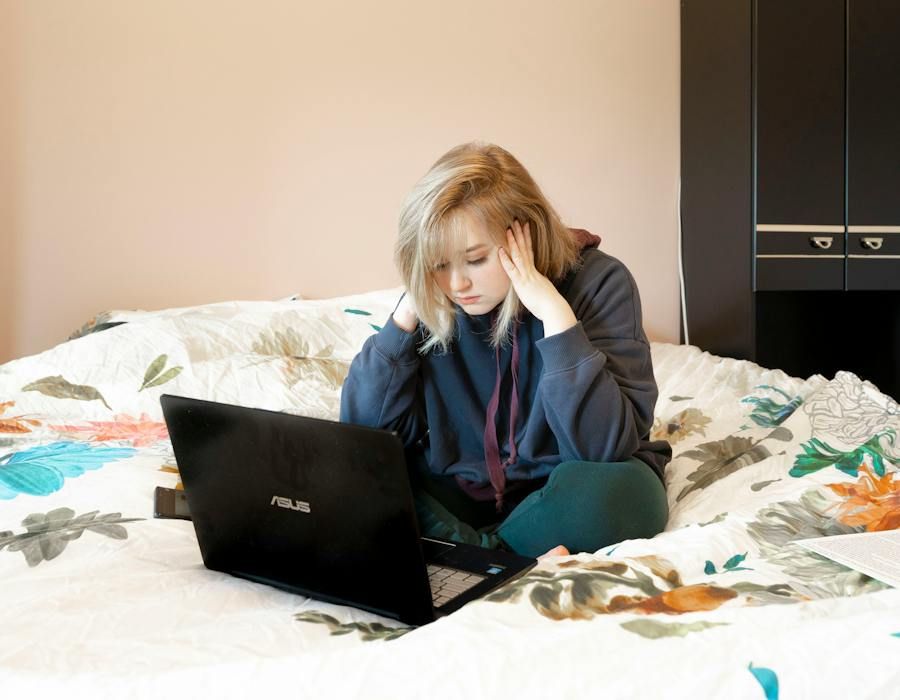Discover the surprising truth about whether is working from home more stressful, and prepare to challenge your assumptions.
Is Working From Home More Stressful?
Are you feeling like a tightrope walker, balancing the demands of work and home in this new era of remote work? As you navigate the treacherous terrain of turning your living space into a makeshift office, you may find yourself wondering if working from home is more stressful.
Well, hold on to that thought, because in this discussion, we will explore the common stressors associated with remote work, which include:
- the impact of isolation and lack of social interaction
- struggles with work-life balance
- challenges in setting boundaries and maintaining productivity
- the role of technology and digital distractions
So, buckle up and get ready to uncover the truth about the potential stress lurking behind the comfort of your home office.
Key Takeaways
– Remote work can bring about various stressors and challenges, including difficulties in managing time effectively, balancing work and personal responsibilities, and establishing clear boundaries and routines.
– The lack of face-to-face interaction and social connections in remote work can lead to feelings of isolation and loneliness, decreased motivation, and negative impacts on productivity.
– Struggles with work-life balance are common when working from home, as it can be challenging to switch off from work-related tasks and establish boundaries between work and personal life.
– Technology and digital distractions can significantly impact productivity and well-being, making it essential to manage screen time, set boundaries, and utilize productivity tools to minimize distractions.

Common Stressors Associated With Remote Work
Working from home can bring about a myriad of stressors that can impact your well-being and productivity. One of the most common challenges associated with remote work is managing time effectively.
Without the structure of a traditional office setting, it can be easy to lose track of time and become overwhelmed with tasks. Balancing work and personal responsibilities becomes crucial, as the boundaries between the two can blur when you work from home.
The lack of physical separation between work and home life can make it difficult to switch off and relax, leading to increased stress levels. In addition, the flexibility of remote work can also be a double-edged sword.
While it allows for greater autonomy and control over your schedule, it can also create pressure to be constantly available and responsive. The expectation to always be online and accessible can lead to feelings of burnout and heightened stress levels.
It’s important to set clear boundaries and establish a routine that allows for dedicated work time and personal time. To effectively manage your time and reduce stress, it’s helpful to establish a daily schedule and prioritize tasks.
Breaking down larger projects into smaller, manageable tasks can make them feel less overwhelming. Utilizing productivity tools and techniques, such as time blocking or the Pomodoro Technique, can also help improve focus and efficiency.
Remember to take regular breaks and engage in activities that promote relaxation and well-being, as self-care is essential in maintaining a healthy work-life balance.
Impact of Isolation and Lack of Social Interaction
How does the lack of social interaction and isolation impact the well-being and productivity of individuals working from home? The effects on mental health can be significant.
Humans are social creatures, and the absence of regular face-to-face interaction can lead to feelings of loneliness, anxiety, and depression. The lack of social support and connection can exacerbate stress levels and decrease overall well-being.
Furthermore, the absence of social interaction can also impact productivity. Social interactions in the workplace often lead to the exchange of ideas, collaboration, and motivation. Without these interactions, individuals may struggle to find the same level of inspiration and creativity.
Additionally, the isolation can lead to feelings of disengagement and decreased motivation, which can negatively impact productivity in the long term.
It’s important for individuals working from home to find ways to combat these effects. Besides, this can include scheduling regular virtual meetings or coffee breaks with colleagues, joining online communities or professional groups, and maintaining a healthy work-life balance.
Taking steps to prioritize social interaction and connection can help mitigate the potential long-term effects of isolation on mental health and productivity.
Struggles With Work-Life Balance When Working From Home
The struggle to maintain a healthy work-life balance becomes increasingly challenging for individuals working from home, as they navigate the impacts of isolation and the absence of regular social interaction.
The integration of work and personal life can blur the boundaries, making it difficult to switch off and disengage from work-related tasks. This constant connectivity can lead to increased stress and burnout, as individuals find it hard to establish a clear separation between their professional and personal lives.
One of the key challenges is setting clear boundaries and establishing a routine that allows for dedicated time to focus on work and personal activities.
Without the physical separation of an office space, it becomes crucial to create a designated workspace and establish set working hours. This can help create a sense of structure and facilitate a better work-life balance. Furthermore, the lack of social interaction that comes with working from home can also impact mental health.
The absence of regular face-to-face interactions with colleagues can lead to feelings of loneliness and isolation. Additionally, the constant pressure to be available and responsive can create feelings of anxiety and overwhelm. To overcome these challenges, it’s important to prioritize self-care and establish boundaries.
Taking breaks, engaging in physical activity, and maintaining social connections outside of work can all contribute to a healthier work-life integration and improved mental well-being. Finding strategies that work for you and being mindful of your own needs can help in achieving a more balanced and fulfilling work-from-home experience.
Challenges in Setting Boundaries and Maintaining Productivity
Setting clear boundaries and maintaining productivity can be a significant challenge when working from home. Without the physical separation between work and personal life, it can be difficult to set priorities and maintain focus on tasks.
The lines between work and personal time often become blurred, leading to a constant state of being ‘on’ and feeling the pressure to always be available. One of the main challenges in setting boundaries is the lack of structure that comes with working from home.
Without the routine of commuting to an office, it can be tempting to work longer hours or allow work to spill into personal time. Equally important, this can lead to burnout and decreased productivity in the long run. Another challenge is the constant distractions that come with being at home.
Household chores, family members, and personal obligations can all compete for your attention and make it difficult to stay focused on work. It’s important to establish clear boundaries with those around you and communicate your work schedule and expectations.
To maintain productivity, it’s crucial to set clear priorities and create a structured work environment. This includes creating a dedicated workspace, establishing a daily routine, and setting specific goals for each day.
By setting boundaries and maintaining focus, you can overcome the challenges of working from home and find a healthy balance between work and personal life.

The Role of Technology and Digital Distractions
With the increasing reliance on technology in our work-from-home environments, it’s important to address the impact of digital distractions on our productivity and overall well-being. Technology distractions have become a significant challenge for many remote workers, as the lines between work and personal life blur.
Constant notifications, the temptation of social media, and the allure of online entertainment can easily divert our attention from the tasks at hand. Managing screen time is crucial in minimizing digital distractions. Setting boundaries and establishing a clear schedule can help create a structured work routine.
Designating specific times for checking emails, social media, or other non-work-related activities can help maintain focus and prevent interruptions. Utilizing productivity tools and apps that block specific websites or limit screen time can also be effective in reducing digital distractions.
However, it’s important to recognize that technology isn’t solely responsible for these distractions. Our habits and self-discipline play a significant role as well.
Being mindful of our digital consumption and consciously making an effort to prioritize work can go a long way. Taking regular breaks, practicing mindfulness, and setting realistic goals can also help improve concentration and productivity.
Ultimately, managing technology distractions requires a proactive approach and self-awareness. By implementing strategies to minimize digital interruptions and fostering a healthy work environment, we can navigate the challenges of remote work more effectively and maintain a better work-life balance.
Frequently Asked Questions
How Can Remote Workers Effectively Combat Feelings of Loneliness and Isolation?
To effectively combat feelings of loneliness and isolation while working remotely, prioritize social connection. Engage in virtual team activities, set up regular video chats with coworkers, and join online communities to foster a sense of belonging and support.
What Strategies Can Be Implemented to Create a Clear Distinction Between Work and Personal Life While Working From Home?
To create a clear distinction between work and personal life while working from home, try setting specific work hours, designating a separate workspace, and taking regular breaks. These strategies can help maintain focus and productivity, and create a healthy work-life balance.
Are There Any Specific Techniques or Tools That Can Help Remote Workers Set Boundaries and Maintain Productivity?
To set boundaries and maintain productivity while working remotely, you can use techniques such as time blocking and tools like project management software. These can help you stay organized, and focused, and reduce the stress of working from home.
What Are Some Potential Negative Effects of Excessive Use of Technology and Digital Distractions While Working Remotely?
Excessive use of technology and digital distractions while working remotely can lead to decreased productivity and increased stress levels. It’s important to set boundaries and prioritize tasks to maintain focus and reduce the negative effects.
How Can Remote Workers Ensure They Are Effectively Managing Their Stress Levels and Avoiding Burnout?
To effectively manage stress and avoid burnout while working remotely, prioritize work-life balance. Set clear boundaries between work and personal life, take regular breaks, and engage in activities that promote relaxation and self-care.
Conclusion
Working from home can be a double-edged sword. While it offers convenience and flexibility, it also brings its fair share of stressors. The isolation and lack of social interaction can take a toll on mental well-being, and balancing work and personal life becomes a constant struggle.
Setting boundaries and staying productive can be challenging in a home environment. Additionally, technology and digital distractions can further add to the stress.
It’s important to recognize and address these issues to maintain a healthy work-life balance while working remotely.
#is working from home more stressful #working from home more stressful
